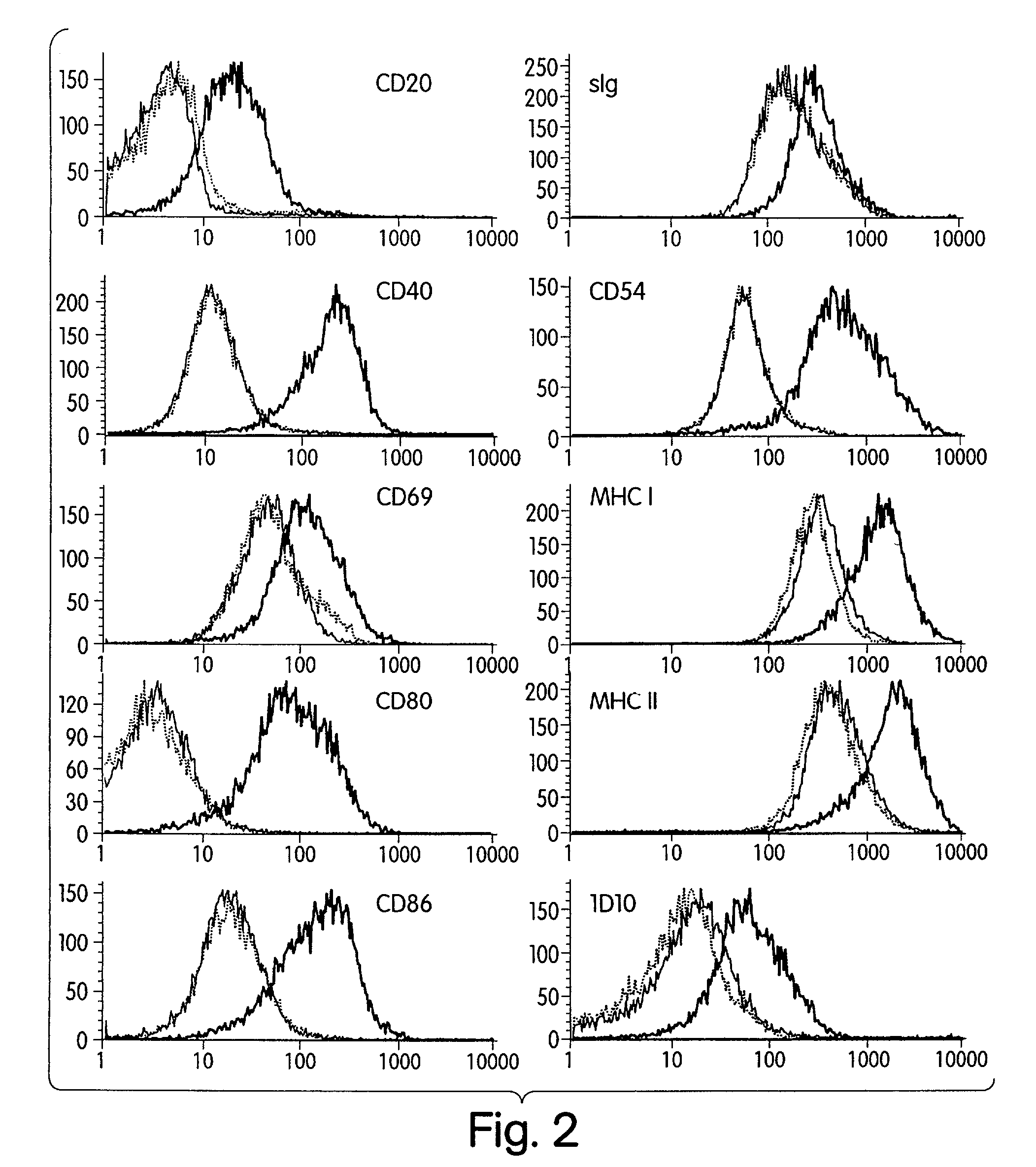Methods for enhancing antibody-induced cell lysis and treating cancer
a technology of immunostimulatory nucleic acids and cell lysis, applied in the direction of antibody medical ingredients, drug compositions, peptides, etc., can solve the problems of increased proliferation rate, less practical in the case of non-solid tumor cancer, surgery and radiation therapy may be more appropriate, etc., and achieve the effect of low levels of cd20 expression
- Summary
- Abstract
- Description
- Claims
- Application Information
AI Technical Summary
Benefits of technology
Problems solved by technology
Method used
Image
Examples
example 1
Immunostimulatory Nucleic Acids Induce Morphological and Phenotypic Changes in Malignant B Cells
[0162]Our prior studies demonstrated that activation of naive human B cells by CpG ODN results in increased cell size (FSC) and granularity (SSC). Hartmann G et al., J Immunol 164:944-53 (2000). We therefore first determined whether such changes also occur in malignant B cells. Primary malignant B cells were obtained from lymph node biopsies, peripheral blood, or pleural fluid of patients with various types of B-cell malignancy. In addition, cells from the lymph node of a patient with benign reactive follicular hyperplasia were studied. Nine samples in total were evaluated (see Table 5). Cells were incubated for 72 hours in media containing CpG ODN 2006 (5 μg / ml) or control ODN 2017. FSC and SSC were examined with gating on CD19+ viable cells (FIG. 1). Varying degrees of change in FSC and SSC were noted in response to CpG ODN 2006 when compared to control ODN 2017 or medium alone. Compara...
example 2
Immunostimulatory Nucleic Acids Induce Proliferation and Apoptosis of Malignant B Cells
[0170]CpG induces a strong proliferative response of primary human B cells. Hartmann G et. al., J Immunol 164:944-53 (2000). Two techniques were used to assess whether CpG ODN is capable of inducing proliferation of B-CLL cells. For select samples, cells were stained with CFSE and incubated for four days. Proliferation of cells is indicated by a loss of CFSE stain with every cell division. In B-CLL, CD5 can be used to identify malignant B cells among CD19+ cells. Proliferation of malignant B cells (CD5+ and CD19+) was lower than proliferation of normal B cells (CD5− and CD19+) (FIG. 5). For the marginal zone lymphoma, CpG ODN 2006 induced proliferation of the CD19+ cell population (FIG. 5).
[0171]FIG. 5 shows a comparison of CpG ODN induced proliferation of malignant and normal B cells. Peripheral blood mononuclear cells from two patients, one with B-CLL and one with marginal zone lymphoma with cir...
PUM
| Property | Measurement | Unit |
|---|---|---|
| Fraction | aaaaa | aaaaa |
| Fraction | aaaaa | aaaaa |
| Fraction | aaaaa | aaaaa |
Abstract
Description
Claims
Application Information
 Login to View More
Login to View More - R&D
- Intellectual Property
- Life Sciences
- Materials
- Tech Scout
- Unparalleled Data Quality
- Higher Quality Content
- 60% Fewer Hallucinations
Browse by: Latest US Patents, China's latest patents, Technical Efficacy Thesaurus, Application Domain, Technology Topic, Popular Technical Reports.
© 2025 PatSnap. All rights reserved.Legal|Privacy policy|Modern Slavery Act Transparency Statement|Sitemap|About US| Contact US: help@patsnap.com



